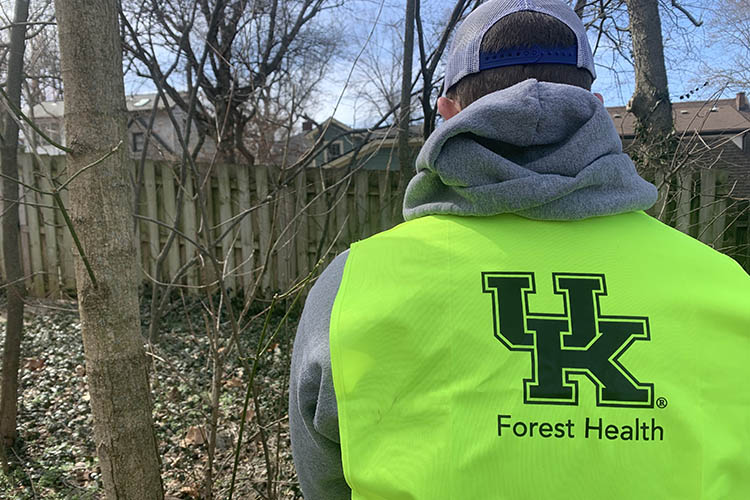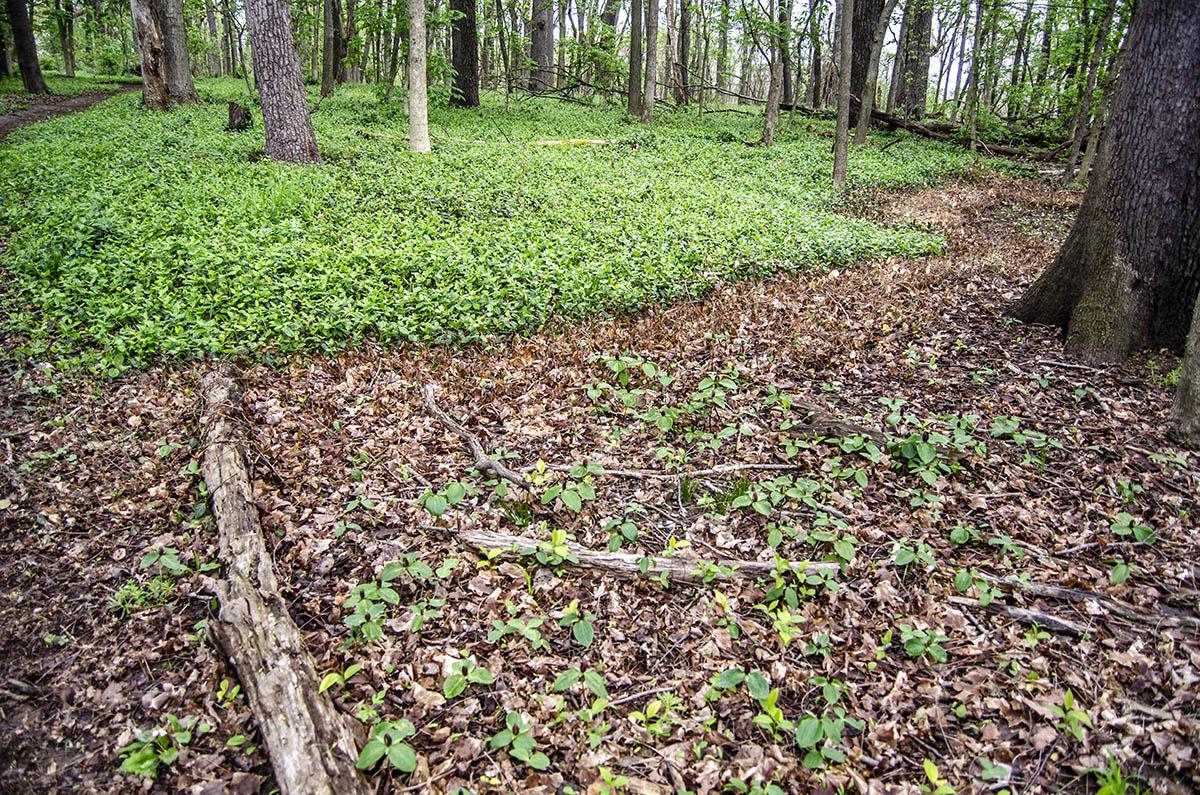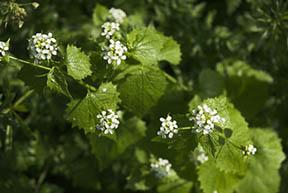Invasive plants are headache for woodland and landscape management
Invasive plants are headache for woodland and landscape management

LEXINGTON, Ky., — When visiting The Arboretum Woods in Lexington on a Friday during spring semester, one might have run into a group of students working hard to defend the woodland from serious invaders.
The students are forestry and natural resources majors who were taking a class on invasive species management taught by Ellen Crocker, assistant professor of forest health in the University of Kentucky College of Agriculture, Food and Environment, with the help of Emily Ellingson, The Arboretum’s curator and native plants collection manager, and Barry Duncill, native plants grounds worker.
The course not only introduced students to guest speakers such as Joyce Bender, head of the Kentucky Invasive Plant Council, but it also provided them with hands-on experience in various invasive plant management techniques. They had to get their Kentucky pesticide applicators license, so they could safely use pesticides. They haven’t sprayed much, however, given the time of year, instead concentrating more on hand-pulling garlic mustard and honeysuckle and using tarps to kill off lesser celandine by heating the soil.
“One of the places we’re really trying to manage (for invasives) is The Arboretum Woods, because it’s a remnant inner Bluegrass woodland. It has an interesting history of being mowed and grazed a long time ago, when UK had an agricultural experiment station on the property,” Ellingson said. “Once those practices were stopped, bush honeysuckle really came into that area. There was a big push in the early 2000s to get rid of the bush honeysuckle, but wintercreeper was waiting by the wayside to come out. Right now, we’ve got almost 100% wintercreeper groundcover in some areas, but we’re trying to reduce that population.”
 Invasive wintercreeper (top) blankets much of The Arboretum Woods. Trilliums, (bottom) a native spring wildflower, are able to reestablish in a spot where wintercreeper has been eradicated. Photo by Carol Lea Spence
Invasive wintercreeper (top) blankets much of The Arboretum Woods. Trilliums, (bottom) a native spring wildflower, are able to reestablish in a spot where wintercreeper has been eradicated. Photo by Carol Lea Spence
Wintercreeper (Euonymus fortunei) is a broad-leafed evergreen plant that can take over an area in a proverbial heartbeat. While it may look lush blanketing the forest floor, its presence can suppress native woodland plants. Native plants, having evolved alongside fauna in the area, provide important food and habitat for local wildlife. In one area of the woods, Ellingson and her team have managed to eradicate a section of wintercreeper and were thrilled to see native trillium beginning to reestablish itself in the space left behind.

Lesser celandine may be a pretty sight in early spring, but it can rapidly take over an area, pushing out native wildflowers on which native fauna depend. Photo by Emily Ellingson.
Lesser celandine (Ficaria verna) sneaks up on people, because it’s a pretty thing with bright yellow, buttercup-like flowers springing up wherever it can get a foothold in lawn or bare ground. In the process, its dense root system and foliage prevent native wildflowers from growing.
“It looks beautiful. It’s one of the first things to come out in the spring, so no wonder people like it and want to plant it,” Crocker said. “But despite those pretty buttercup flowers, it will completely take over. It will carpet whole areas, so nothing else is growing there. And then it goes dormant, and all that soil is more likely to erode, and you could have other invasive issues.”
Crocker said Northern Kentucky has a lot of it, and it’s now been found in Central Kentucky. The plant reproduces three ways, by seed, by tuberous roots and by small bulbils attached to the base of the leaf stalk. These bulbils easily can be washed away in heavy rain or floods or carried by wildlife, so lesser celandine’s range can be quite wide.
Ellingson suggested, following manufacturer’s instructions, spraying lesser celandine with a glyphosate-based herbicide when it is in its vegetative state before blooms appear.

Garlic mustard is a biennial plant, meaning it blooms in its second year, reseeds itself, then dies. Best to pull it out in its first year or before it goes to seed. Photo by Marbury, iPhoto/Getty Images Plus
Garlic mustard (Alliaria petiolata) is also a nonnative invasive plant that many will encounter in the spring. Garlic mustard is a biennial, meaning that the first season it just puts out leaves, in the shape of a basal rosette. The second year, it will bloom. Ellingson said they pull it out by hand before the plant goes to seed.
“And don’t forget about the Callery pear,” Crocker said. “Most people know it as a Bradford pear, which is just one cultivar. There are many different varieties of Callery pears, and they have moved into old field sites and roadsides. In the spring, if you drive around and see something flowering white in old fields, it’s probably Callery pear.”
Callery pears form dense, thorny thickets that prevent native plants from getting a toehold.
“I think we’re always going to have nonnatives,” Crocker said. “In my mind, it’s not really bad to have some nonnative species. You just want to have your vigorous native species, too, because they are not only adapted to our areas and provide biodiversity, but they also support the insects, they support the animals. A lot of invasives and nonnatives don’t have those same relationships with our ecosystem.”
Forestry & Natural Resources Research


